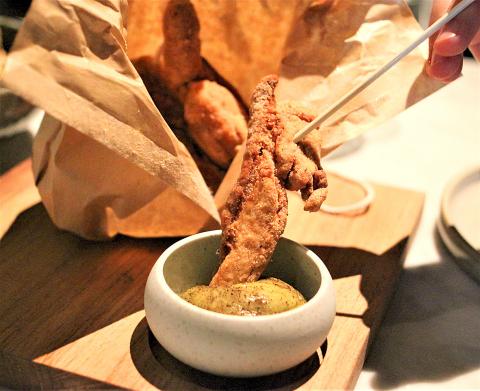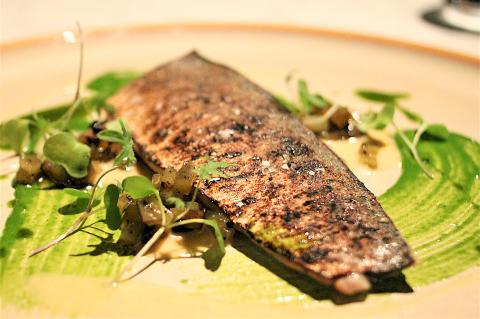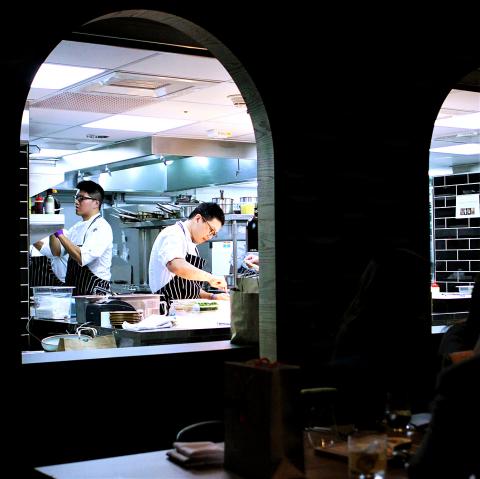The lobby of Taipei’s Kimpton Daan Hotel on Renai Road (仁愛路) has the inexplicable herbal aroma and minimalist look of a place that is not content to be just a hotel, but insists on being a lifestyle. This thought distracts me as a kind bellboy presses an elevator button sending us up to the 12th floor, where the Kimpton’s in-house restaurant The Tavernist is located.
Even before its opening this month, The Tavernist’s prestigious lineage had already garnered it considerable hype. British culinary director James Sharman is a disciple of Rene Redzepi, the celebrated Danish chef whose rule-breaking restaurant Noma in Copenhagen is considered by the culinary realm’s designated taste-makers to be one of the most influential in the world.
The Kimpton itself has a name to uphold, as the pioneer and largest purveyor of the boutique hotel concept in the US. The hotel in Daan District (大安) opened last year and is Kimpton’s first foray into Asia, with projects expected to follow in Indonesia (Bali) this year and China (Shanghai and Sanya) by 2021. The group’s decision to make its Asian debut in Taipei suggests confidence in the city’s appeal to a cache of young, well-heeled and worldly consumers. It’s an aspirational and urbane infusion of hospitality that Taiwan could use more of.

Photo: Davina Tham, Taipei Times
All of this feeds into high anticipation of dinner at The Tavernist. On a Friday night, it was packed with groups of fashionable local creatives and executives alike. Mood lighting and dark-hued furnishings confirm the restaurant’s fashionableness. A spacious bar and rooftop are prime real estate for soaking in the city’s glittery, mild-weathered nights, with an enticing list of cocktails and mocktails using local ingredients.
Service staff are warm but professional. All are well-rehearsed in a script introducing menu highlights, which they can and do rattle off at the drop of a hat. The recommended plates have either unique Asian inflections or humanizing backstories — the waiter’s introduction of baby chicken with bread sauce (NT$880) mentions Sharman’s memory of a grandmother serving a similar dish to her grandchild at his Airbnb in Copenhagen.
But we’re in Taiwan, and the most intriguing dishes are inspired by local street food culture. First, a complimentary aperitif of hazelnut milk topped with salty, rose-scented foamed milk, or nai gai (奶蓋), is a quick riff on bubble tea.

Photo: Davina Tham, Taipei Times
Fried chicken with kombu, or Japanese kelp dip (NT$450), is a nod to Taiwanese popcorn chicken (鹹酥雞). It’s served in a brown paper bag, which I tear open before using a bamboo stick to skewer the deep-fried, skin-on, de-boned dark meat. The moss-colored kombu dip imparts an addictive minerally, salty umami, like a sophisticated version of the seaweed-flavored condiment in McDonald’s shaker fries from my childhood.
By invoking popcorn chicken in this restrained setting, The Tavernist actually underscores its inability to capture the insouciant magic of eating deep-fried chicken standing up by the roadside, biting into meat so hot that your teeth hurt, steam erupts from your mouth and chicken juice runs down the soaked bag and onto your shoe.
But maybe this is a good thing. Maybe a merely partial translation of Taiwan’s night markets will draw more hotel guests out to the real thing, giving them a frame of reference to better make sense of the cacophony.

Photo: Davina Tham, Taipei Times
Baked Alaska with taro ice cream (NT$590), served on a croissant and flowing with Cognac-spiked custard, pays homage to the famous deep-fried taro balls of Ningxia Night Market (寧夏夜市). It’s best shared among a table so that everyone gets a modest serving, as there is little to contrast the layers of sweet upon sweet.
The rest of the menu is inspired by a collection of other global encounters by Sharman, with some hits and misses.
Charred mackerel with cilantro and barley sauces (NT$600) is well-seasoned and juicy, but both the choice of fish and flavor combination seem a little too common for Taiwan, given how The Tavernist has been marketed. An appetizer of roasted cauliflower with Gruyere fondue (NT$390) is similarly challenged, although the cauliflower is beautifully bronzed and flavorful even on its own.

Photo: Davina Tham, Taipei Times
Instead, although I did not get to try it, the grouper with pumpkin and pine nuts (NT$720) deserves an honorary mention. The dish, presented in a whole gourd, has an opulence that would be at home on a Chinese banquet table.
Pork belly and tenderloin (NT$950) rest on a loaf-sized sugarcane grill that references Kenyan cooking. The pork belly has structural issues, as taking a knife to it causes the fat to lose its integrity under the crackling and ooze out into grease. But it’s worth ordering for the standout pineapple sauce alone. Savory pineapple caramel flecked with vanilla bean is reminiscent of pineapple tart filling that has been cooked so long, it has pushed into the ambrosial bitterness of burnt sugar and broken down into a deep copper lava.
The Tavernist does not aim for a deep and well-rounded excursion into Taiwanese cuisine — understandable, as it’s unlikely the Kimpton’s guests are expecting that of an in-house restaurant. But it’s a heartening development all the same to see local street eats interpreted for the fine-dining table. This ambition for showcasing a best-hits version of Taipei to the cosmopolitan traveler is worth encouraging.

Photo: Davina Tham, Taipei Times

May 26 to June 1 When the Qing Dynasty first took control over many parts of Taiwan in 1684, it roughly continued the Kingdom of Tungning’s administrative borders (see below), setting up one prefecture and three counties. The actual area of control covered today’s Chiayi, Tainan and Kaohsiung. The administrative center was in Taiwan Prefecture, in today’s Tainan. But as Han settlement expanded and due to rebellions and other international incidents, the administrative units became more complex. By the time Taiwan became a province of the Qing in 1887, there were three prefectures, eleven counties, three subprefectures and one directly-administered prefecture, with

Taiwan Power Co (Taipower, 台電) and the New Taipei City Government in May last year agreed to allow the activation of a spent fuel storage facility for the Jinshan Nuclear Power Plant in Shihmen District (石門). The deal ended eleven years of legal wrangling. According to the Taipower announcement, the city government engaged in repeated delays, failing to approve water and soil conservation plans. Taipower said at the time that plans for another dry storage facility for the Guosheng Nuclear Power Plant in New Taipei City’s Wanli District (萬里) remained stuck in legal limbo. Later that year an agreement was reached

What does the Taiwan People’s Party (TPP) in the Huang Kuo-chang (黃國昌) era stand for? What sets it apart from their allies, the Chinese Nationalist Party (KMT)? With some shifts in tone and emphasis, the KMT’s stances have not changed significantly since the late 2000s and the era of former president Ma Ying-jeou (馬英九). The Democratic Progressive Party’s (DPP) current platform formed in the mid-2010s under the guidance of Tsai Ing-wen (蔡英文), and current President William Lai (賴清德) campaigned on continuity. Though their ideological stances may be a bit stale, they have the advantage of being broadly understood by the voters.

In a high-rise office building in Taipei’s government district, the primary agency for maintaining links to Thailand’s 108 Yunnan villages — which are home to a population of around 200,000 descendants of the Chinese Nationalist Party (KMT) armies stranded in Thailand following the Chinese Civil War — is the Overseas Community Affairs Council (OCAC). Established in China in 1926, the OCAC was born of a mandate to support Chinese education, culture and economic development in far flung Chinese diaspora communities, which, especially in southeast Asia, had underwritten the military insurgencies against the Qing Dynasty that led to the founding of